Every player takes on the role of a character who interacts with and explores a world described by the Game Leader. The character’s capabilities are defined by their potential and advantages.
- Potential is how much a character can do
- Advantages are what they can do and how well they do it
When characters face danger, a difficult challenge or any situation where the outcome is uncertain, they use their advantages and potential to take an action. Characters have a limited amount of potential available and tokens or small coins are ideal for tracking how much has been used.
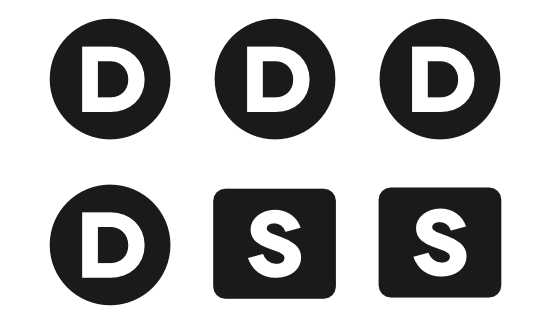
There are two types of potential: Dynamic potential is for the direct and immediate. Static potential is for more complex advantages. Different coloured or sized tokens should be used to track each type of potential. New characters start with four dynamic potential and two static potential.
ADVANTAGES
Advantages are found on the character sheet and each character often starts with a unique mix of around fifteen advantages.
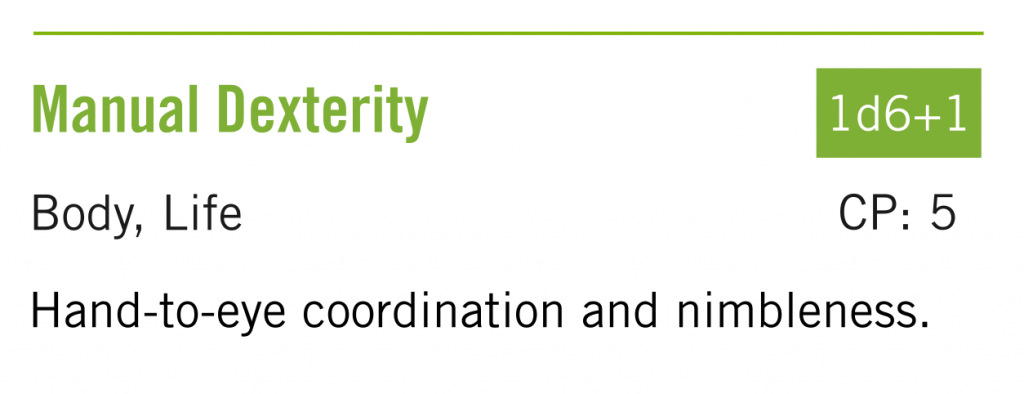
Advantages come in a range of colours. The colours are a guide to the type of advantage but most of the time the colour is not important.

Each advantage contains a title and summary describing the advantage which may include special instructions relating to its effects.

The advantage’s keywords define the type of advantage (e.g. Life or Skill), add descriptive details (e.g. Two-Handed, Armour) and indicate certain rules which apply to the advantage (e.g. Range or Blast).

The CP (Character Points) and dice value decide how powerful or effective the character is with this type of advantage. Advantages have dice values between 1d6+0 and 1d6+6 and a CP of between 4 and 25. Most advantages require dynamic potential to use but some are static and need static potential. Other than the type of potential used, static and dynamic advantages are identical. Any advantage which does not say static under the dice value uses dynamic potential.

Equipment
There are two types of equipment: yellow character equipment and pink mundane equipment. Character equipment covers signature items such as the gun-fighter’s pearl-handled revolvers or the musician’s guitar. These have CP and dice values like other advantages.
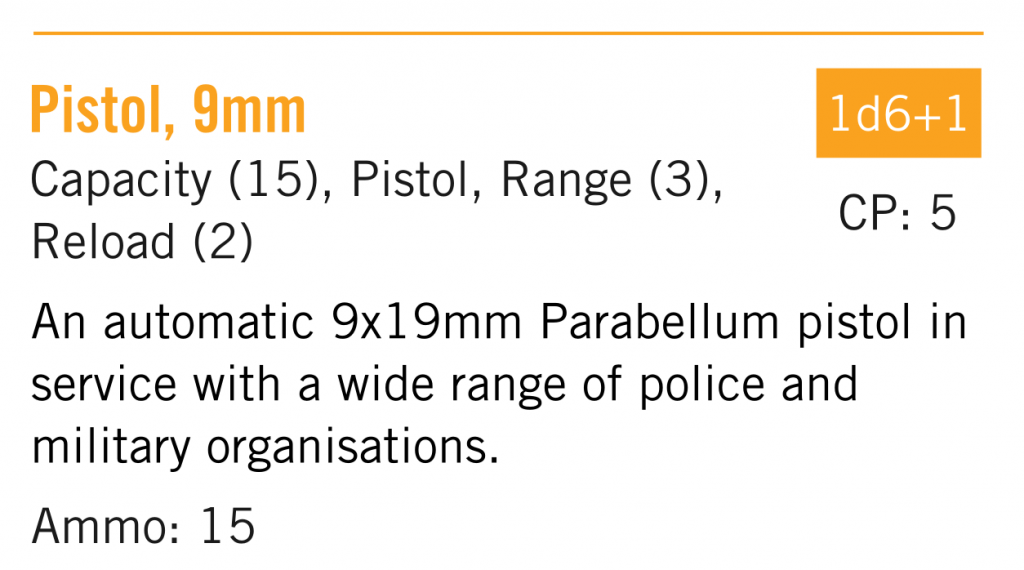
Mundane equipment is everything else the character uses or controls. It can be anything from a rock picked off the ground to the interstellar spaceship they are piloting. Mundane equipment is always worth 1d6+0. Mundane and character equipment both cost potential to use, normally dynamic potential.

Mundane equipment is everything else the character uses or controls. It can be anything from a rock picked off the ground to the interstellar spaceship they are piloting. Mundane equipment is always worth 1d6+0. Mundane and character equipment both cost potential to use, normally dynamic potential.
ACTIONS
Whenever a character wishes to do something important and the outcome is uncertain, they take an action. Players state what the character is trying to achieve (this is known as the action focus) and use one or more advantages. The dice values of each advantage are added together to give the total number of dice and modifiers.
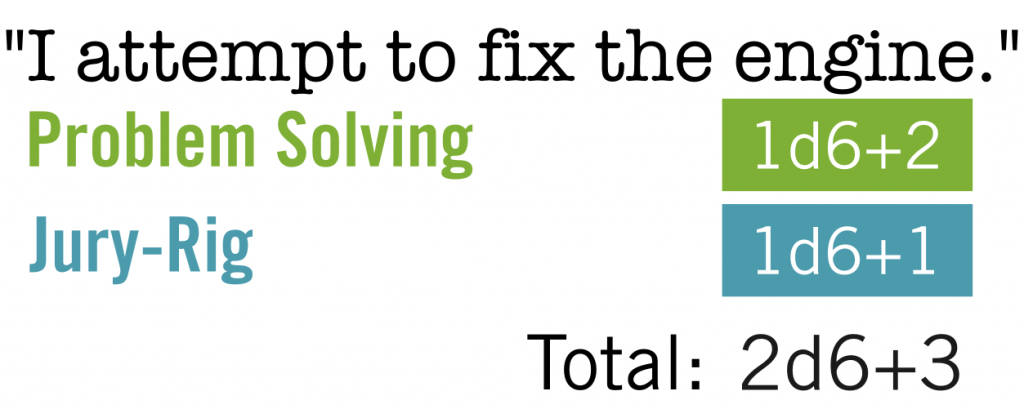
Actions may combine any advantages as long as they are:
- Available — they are on the character sheet and not lost due to injury
- Appropriate — the advantage makes sense in combination with the other advantages being used and the action’s stated aim
The whole group decides whether a particular combination of advantages is appropriate. Most of the time common sense ensures approval is automatic but occasionally people will disagree. The player must explain and convince the group why the advantages make sense in this situation. Emphasis should be placed on role playing and players are encouraged to add detail and colour to their explanations.
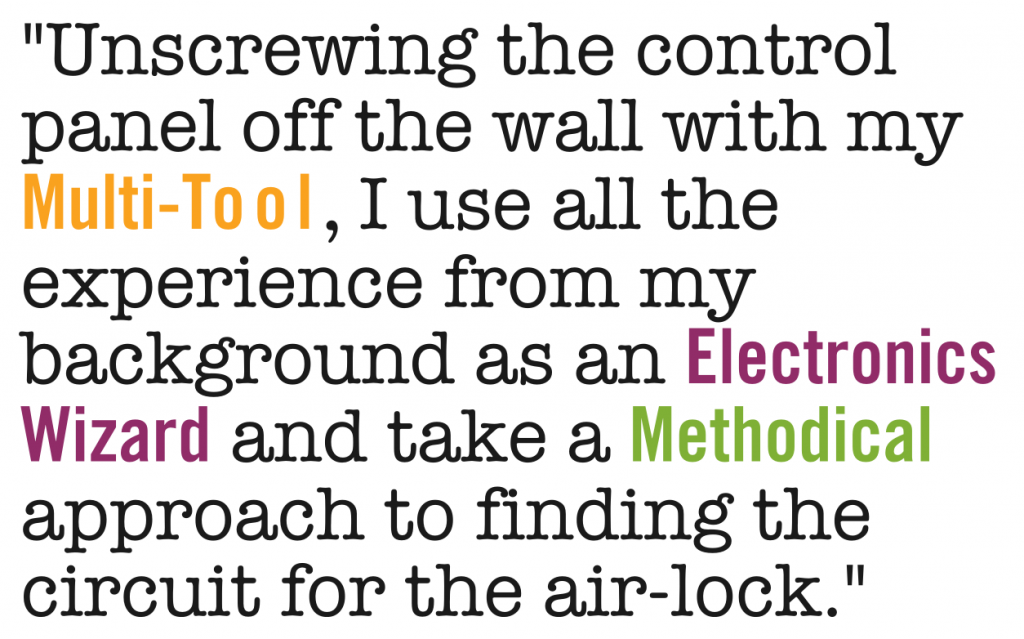
The number of advantages used in an action is only limited by the character’s potential. Each dynamic advantage requires a dynamic potential token, each static advantage needs a static potential token.

Characters may gain situation bonuses on their actions from anything which makes the character’s action notably easier. Each bonus adds 1d6+0 to the character’s action and characters can gain multiple bonuses. Situations which make the character’s actions harder add 1d6+0 bonuses to their opponent’s action. There is no limit to the number of dice a character may roll in an action and it can involve seven or more.
Success or Failure
For an action to be successful, its dice score must beat the resistance score. The character rolls the dice for each advantage plus any dice for situation bonuses, and totals the dice and the advantage’s modifiers (e.g +1). Watch out for advantages with the Dice keyword which may allow rerolls or describe other special behaviour in the summary.
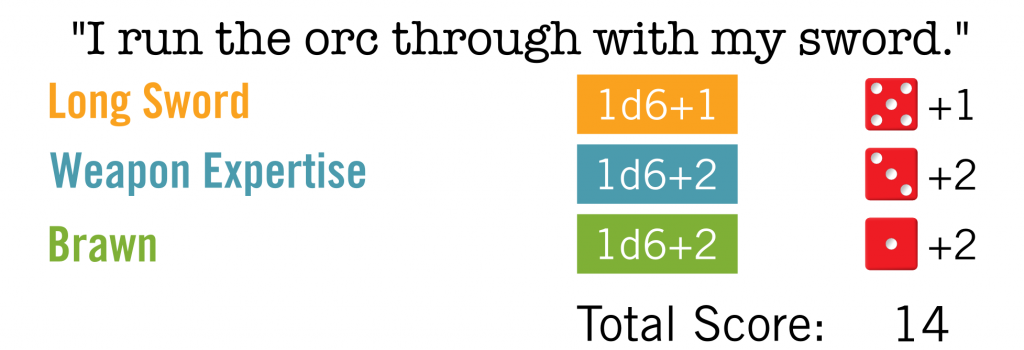
The resistance score is the target score to beat. Depending on the circumstances this can be a score set by the Game Leader or can be the result of an opponent’s action.
NARRATIVE PLAY
Narrative covers everything outside of combat. In narrative play the characters may use all their potential in a single action and take as many actions as needed. Starting characters have four dynamic potential and two static potential, allowing them to take an action involving up to four dynamic advantages and two static advantages. Generally only an expert at a particular task will have enough appropriate advantages to use all six of their potential in one action. Most characters, most of the time, will have two to four suitable advantages for any given task. If a character has time and space to concentrate on an action, they can spend one spare dynamic potential for an extra 1d6+0. This depends on the situation and may have drawbacks if something unexpected happens.
All characters will face situations where they lack any advantages which are appropriate and available for the task. In these circumstances they may take a potential action which uses a single dynamic potential for a dice score of 1d6+0.
COMBAT
In combat, potential is the difference between life and death. Each action taken spends potential but it is only recouped at a fixed rate. Spend too much potential on an action and the character will have nothing left to defend themselves with. Each player uses two areas next to their character sheet to hold potential. One is the bank where unused potential is kept and one is the spent pile for used potential.
Readiness
Characters do not always start combat with all their potential in their bank. Each charac- ter’s readiness for the fight is decided by the group based on the situation. A character who is 100% ready for a fight will have all their potential available when combat starts.

An unprepared character will have some dynamic potential already in their spent pile.

Someone caught completely by surprise, for example if they were sleeping, would begin the combat with all their dynamic potential in the spent pile.

Taking Turns
Combat is divided into rounds. During a round each player and all opponents have a turn. At the end of each turn the player or Game Leader nominates the next person to have their turn. This must be someone who has not yet had a turn this round. If everyone has already had a turn the round finishes, a new round begins and the player may nominate anyone except themselves. Players and Game Leaders can override the nomination process by seizing the initiative. The characters’ potential is bid until someone yields, with the winning character having to spend that much of their potential.
Acting
Whenever a character takes an action they must spend potential, one per advantage being used. Static advantages cost static potential, dynamic advantages cost dynamic potential. The used potential is moved to the spent pile.
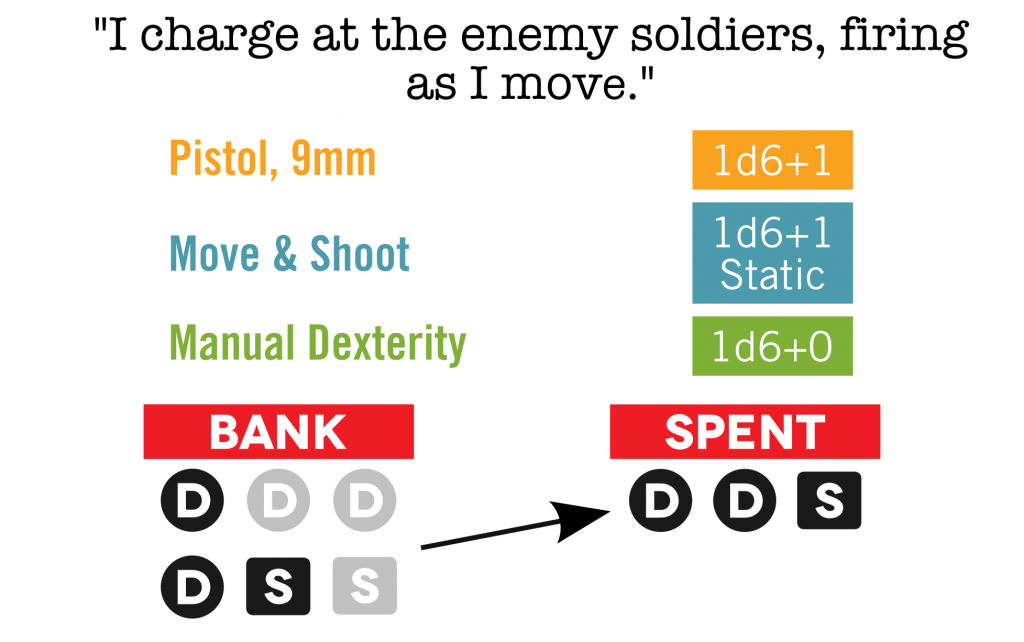
Characters may take any number of actions during their turn, which ends when they run out of potential or decide to stop. At the Game Leader’s discretion characters can also take minor actions, such as dropping objects or speaking, without spending potential.
Recoup
During their turn a character may recoup two dynamic potential tokens. Recouping moves potential tokens from the spent pile into the bank.

Characters may act and recoup in any order during their turn. They may also split their recoup, allowing them to recoup one dynamic potential token, then act, then recoup their second dynamic potential. A character wishing to recoup more dynamic potential or to recoup static potential may choose to do nothing. By taking no actions and spending no potential during their turn, the character has a chance to rest. This allows them to recoup three tokens.

Any combination of static and dynamic tokens may be recouped but the total number of tokens moved from the spent pile to the bank cannot exceed three.
Movement
Characters move by taking actions. If they have an advantage with the Movement keyword they may use it in combination with other advantages for a single large movement. Most characters have to rely on a potential action for movement. This costs one dynamic potential and players have a choice to either mosey or run. A mosey (or walk) is guaranteed movement, the equivalent of rolling 3 on the dice.
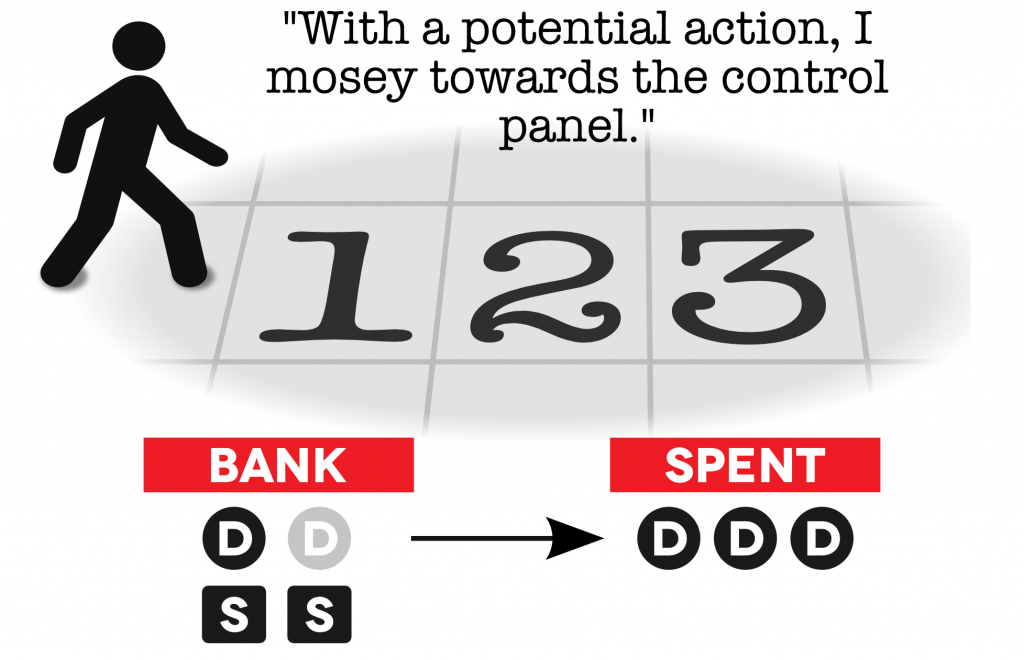
Run is less predicable but can take you further. Roll 1d6+0 to the determine the distance moved.
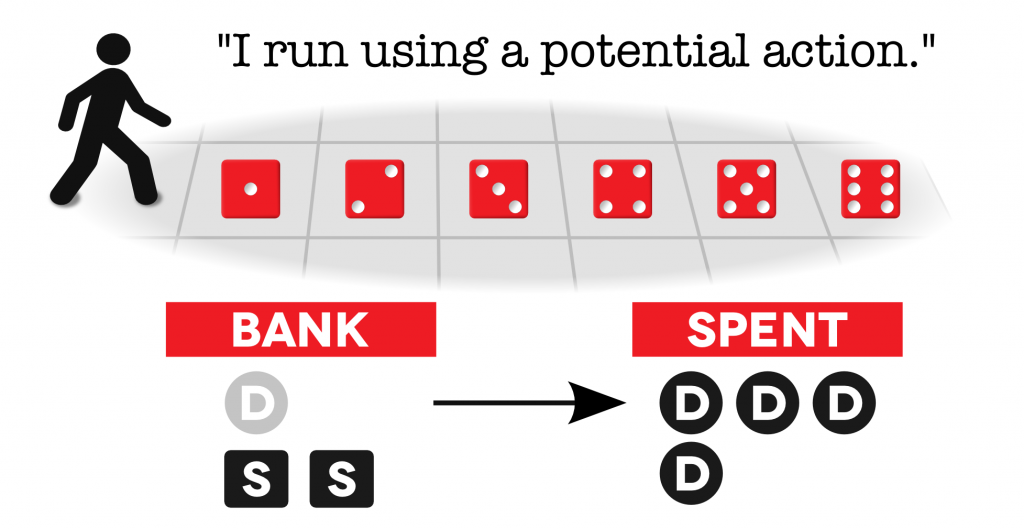
Characters may move several times in a turn by taking multiple movement actions, switching between moseying and running as desired.
Being Attacked
Any time a character is attacked (by an opponent or a trap or anything which endangers the character) they have a resistance action to protect themselves. The resistance action is the same as a normal action, requiring potential to be spent on advantages which are appropriate and available.
The resistance may involve passive defences, such as armour, or the more active protection of dodging or parrying. It can also involve counter-attacks with weapons, including returning fire. Anything which reduces the threat or makes it harder for the attacker is a valid form of defence. The resistance action must make sense for the type of attack and the advantages used in defence must be compatible with each other.
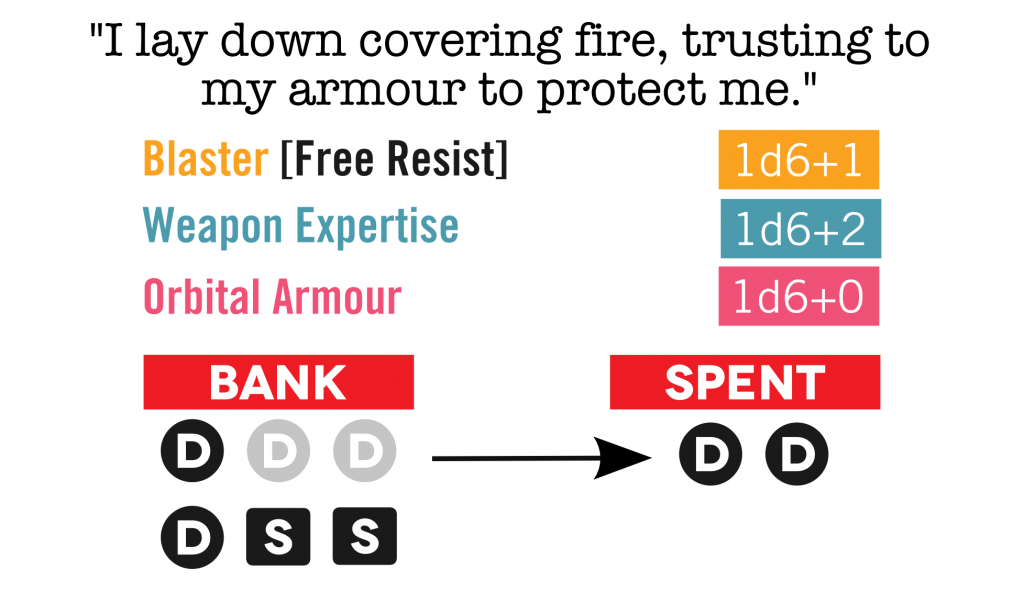
Each character has a free resist advantage listed on their character sheet. This advantage can be used in a resistance action without spending potential. The chosen free resist is fixed and players cannot change the advantage without consultation with the Game Leader and a suitable retraining period for their character. As with any other advantage used in an action, it must be available and be appropriate for the situation. Common free resists include armour, weapons and abilities such as Dodge. These are suitable against some forms of attack but will be inappropriate against other dangers such as magic or poison gas.
If a character is unable to defend themselves due to a shortage of potential, lacking a suitable free resist or being unconscious, they always have a resistance score of one. Note this is a score of one, not one dice, so a character caught out like this is almost guaranteed to be hit by the attack.

The resistance action’s score sets the target which the attacker must beat. If the attacker scores less than or equal to the resistance the character escapes unharmed, but if the attack exceeds the resistance the character is hurt. How hurt they are is the difference between the two rolls, known as the degree of success.
Taking Damage
Characters who are hurt by attacks must discard their green Life advantages by placing an X or similar mark next to the advantage on the character sheet. Discarded advantages are not available and may not be used in actions until they have been recovered via healing.

The injured character must discard Life advantages whose total CP value equals or exceeds the damage (the degree of success). The player may choose the Life advantages they wish to discard for the damage. As well as considering the CP value of advantages it is also worth considering the usefulness of the advantage. Sometimes it is better to discard one high value advantage than two lower value advantages.
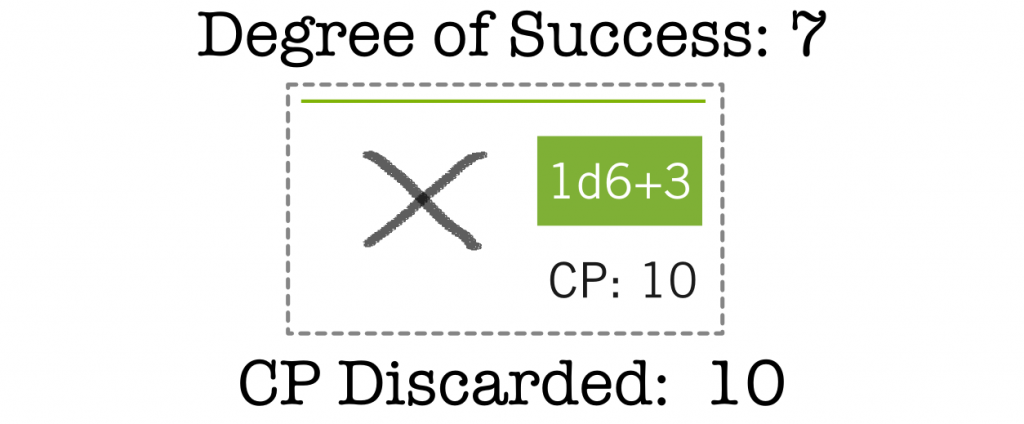
Players cannot discard part of an advantage. Even if just one point of damage is taken, a whole advantage must be discarded.
Anticipating
At the end of a character’s turn, they may choose to use unspent dynamic potential to anticipate an upcoming resistance action. Potential tokens are placed on advantages the player thinks the character will need to use in a resistance action before their next turn. If the character does have to make a resistance action using the anticipated advantages, the potential assigned goes into the bank. If the anticipated advantages are not used before the character’s next turn, the assigned potential is moved to the spent pile.
Keywords In Combat
There are several keywords which are important in combat. Full details are in the Core rules along with a complete list of keywords, but the most important are:
- Aid Other – Help an ally with their action
- Aid Resist – Help an ally defend themselves
- Opportunity – Take an action during someone else’s turn
- Range – How far away the target may be before giving situation bonuses to the opponent
- Status – Adds an ongoing status effect to the target.
